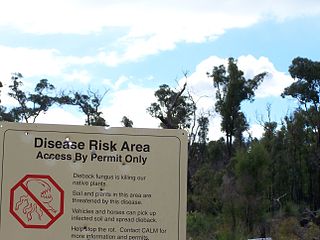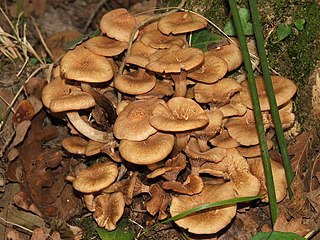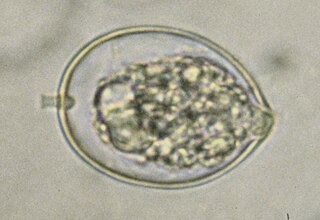
Armillaria is a genus of fungi that includes the A. mellea species known as honey fungi that live on trees and woody shrubs. It includes about 10 species formerly categorized summarily as A. mellea. Armillarias are long-lived and form the largest living fungi in the world. The largest known organism covers more than 3.4 square miles (8.8 km2) in Oregon's Malheur National Forest and is estimated to be 2,500 years old. Some species of Armillaria display bioluminescence, resulting in foxfire.

Botrytis cinerea is a necrotrophic fungus that affects many plant species, although its most notable hosts may be wine grapes. In viticulture, it is commonly known as "botrytis bunch rot"; in horticulture, it is usually called "grey mould" or "gray mold".

Texas root rot is a disease that is fairly common in Mexico and the southwestern United States resulting in sudden wilt and death of affected plants, usually during the warmer months. It is caused by a soil-borne fungus named Phymatotrichopsis omnivora that attacks the roots of susceptible plants. It was first discovered in 1888 by Pammel and later named by Duggar in 1916.

Armillaria mellea, commonly known as honey fungus, is a basidiomycete fungus in the genus Armillaria. It is a plant pathogen and part of a cryptic species complex of closely related and morphologically similar species. It causes Armillaria root rot in many plant species and produces mushrooms around the base of trees it has infected. The symptoms of infection appear in the crowns of infected trees as discoloured foliage, reduced growth, dieback of the branches and death. The mushrooms are edible but some people may be intolerant to them. This species is capable of producing light via bioluminescence in its mycelium.

Phytophthora cinnamomi is a soil-borne water mould that produces an infection which causes a condition in plants variously called "root rot", "dieback", or, "ink disease". The plant pathogen is one of the world's most invasive species and is present in over 70 countries around the world.

Armillaria luteobubalina, commonly known as the Australian honey fungus, is a species of mushroom in the family Physalacriaceae. Widely distributed in southern Australia, the fungus is responsible for a disease known as Armillaria root rot, a primary cause of Eucalyptus tree death and forest dieback. It is the most pathogenic and widespread of the six Armillaria species found in Australia. The fungus has also been collected in Argentina and Chile. Fruit bodies have cream- to tan-coloured caps that grow up to 10 cm (4 in) in diameter and stems that measure up to 20 cm (8 in) long by 1.5 cm (1 in) thick. The fruit bodies, which appear at the base of infected trees and other woody plants in autumn (March–April), are edible, but require cooking to remove the bitter taste. The fungus is dispersed through spores produced on gills on the underside of the caps, and also by growing vegetatively through the root systems of host trees. The ability of the fungus to spread vegetatively is facilitated by an aerating system that allows it to efficiently diffuse oxygen through rhizomorphs—rootlike structures made of dense masses of hyphae.

Armillaria tabescens is a species of fungus in the family Physalacriaceae. It is a plant pathogen. The mycelium of the fungus is bioluminescent.

Ceratocystis fimbriata is a fungus and a plant pathogen, attacking such diverse plants as the sweet potato and the tapping panels of the Para rubber tree. It is a diverse species that attacks a wide variety of annual and perennial plants. There are several host-specialized strains, some of which, such as Ceratocystis platani that attacks plane trees, are now described as distinct species.

Phytophthora cactorum is a fungus-like plant pathogen that causes root rot on rhododendron and many other species.

Sclerotinia sclerotiorum is a plant pathogenic fungus and can cause a disease called white mold if conditions are conducive. S. sclerotiorum can also be known as cottony rot, watery soft rot, stem rot, drop, crown rot and blossom blight. A key characteristic of this pathogen is its ability to produce black resting structures known as sclerotia and white fuzzy growths of mycelium on the plant it infects. These sclerotia give rise to a fruiting body in the spring that produces spores in a sac which is why fungi in this class are called sac fungi (Ascomycetes). This pathogen can occur on many continents and has a wide host range of plants. When S. sclerotiorum is onset in the field by favorable environmental conditions, losses can be great and control measures should be considered.

Heterobasidion annosum is a basidiomycete fungus in the family Bondarzewiaceae. It is considered to be the most economically important forest pathogen in the Northern Hemisphere. Heterobasidion annosum is widespread in forests in the United States and is responsible for the loss of one billion U.S. dollars annually. This fungus has been known by many different names. First described by Fries in 1821, it was known by the name Polyporus annosum. Later, it was found to be linked to conifer disease by Robert Hartig in 1874, and was renamed Fomes annosus by H. Karsten. Its current name of Heterobasidion annosum was given by Brefeld in 1888. Heterobasidion annosum causes one of the most destructive diseases of conifers. The disease caused by the fungus is named annosus root rot.
Rosellinia bunodes is a plant pathogen infecting several hosts including avocados, bananas, cacao and tea.

Artocarpus nobilis, the Ceylon breadfruit, is a tree species in the family Moraceae. It is endemic to south western regions of Sri Lanka. It is known as "Wal dhel - වල් දෙල්", "Baedi dhel - බැදි දෙල්" or as "Hingala dhel - හිංගල දෙල්" by local people.

Laminated root rot also known as yellow ring rot is caused by the fungal pathogen Phellinus weirii. Laminated root rot is one of the most damaging root disease amongst conifers in northwestern America and true firs, Douglas-fir, Mountain hemlock, and Western hemlock are highly susceptible to infection with P. weirii. A few species of plants such as Western white pine and Lodgepole pine are tolerant to the pathogen while Ponderosa pine is resistant to it. Only hardwoods are known to be immune to the pathogen.

Armillaria novae-zelandiae is a species of mushroom in the family Physalacriaceae. This plant pathogen species is one of three Armillaria species that have been identified in New Zealand.

Armillaria root rot is a fungal root rot caused by several different members of the genus Armillaria. The symptoms are variable depending on the host infected, ranging from stunted leaves to chlorotic needles and dieback of twigs and branches. However, all infected hosts display symptoms characteristic of being infected by a white rotting fungus. The most effective ways of management focus on limiting the spread of the fungus, planting resistant species, and removing infected material. This disease poses a threat to the lumber industry as well as affecting recreational areas.

Armillaria ostoyae is a species of fungus (mushroom), pathogenic to trees, in the family Physalacriaceae. In the western United States, it is the most common variant of the group of species under the name Armillaria mellea. A. ostoyae is common on both hardwood and conifer wood in forests west of the Cascade Range in Oregon, United States. It has decurrent gills and the stipe has a ring. The mycelium invades the sapwood and is able to disseminate over great distances under the bark or between trees in the form of black rhizomorphs ("shoestrings"). In most areas of North America, Armillaria ostoyae can be separated from other species by its physical features: cream-brown colors, prominent cap scales, and a well-developed stem ring distinguish it from other Armillaria.

Heterobasidion irregulare is a tree root rotting pathogenic fungus that belongs to the genus Heterobasidion, which includes important pathogens of conifers and other woody plants. It has a wide host and geographic range throughout North America and causes considerable economic damage in pine plantations in the United States. This fungus is also a serious worry in eastern Canada. Heterobasidion irregulare has been introduced to Italy (Lazio)(modifica) where it has been responsible for extensive tree mortality of stone pine. Due to the ecology, disease type, host range/preference, interfertility group, and genetic information, H. irregulare was designated a new species and distinguished from Heterobasidion occidentale.
Stem rot is a disease caused by a fungus infection in the stem. Fungus that causes stem rot are in the Rhizoctonia, Fusarium or Pythium genera. Stem rot can readily infect crops that are in their vegetative or flowering stages. The disease can survive up to five years in the soil. Symptoms of stem rot includes staining of infected area, reduced crop yield and crop failure. The disease can be spread through the use of unfiltered water as well as unsterilized tools. Also leaving previous dead roots in soil can increase the risk of stem rot. Spores can also enter the plant through injured stem tissue on the plant including from insect attacks. The fungus impedes stem functions like transporting nutrients. It can cause water to leak through the lesions of stem tissue. Common infected crop plants are soybeans and potatoes. An issue with maintaining this disease is the lack of management by crop producers. Producers of soybeans tend to not manage for the disease because it is not normally yield limiting in a large area. Fungicides can be used to manage the disease as well as burning the crop after harvest or letting it decompose.















